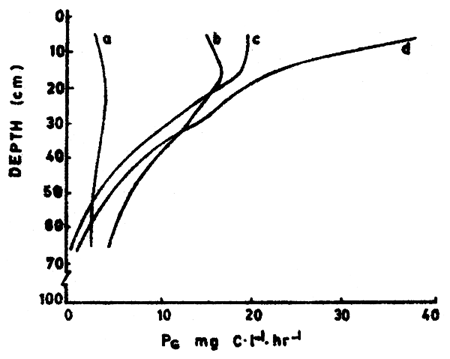From the above discussion it would be obvious that fish production (FY) (secondary production) in natural and tended waters should be related to primary production (PG) of water bodies concerned. As indicated already several attempts have been made to correlate these FY with PG.
We also indicated that the dissolved solids (nutrient load) measurable as conductivity of the water concerned, have been well correlated with the production of fish (fish yield). The Mospho-Edaphic Indix (MEI), referred to above, (the productivity of the water bodies is directly correlated with conductivity and inversely correlated with depth of the water body), has been found to be correlating well with fish yield in African lakes (Henderson and Wellcome, 1974; Melack, 1976). Melack compared fish yields of 8 African lakes with corresponding PG and obtained a relation:
Log. FY = 0.113 PG + 0.91; r = 0.57
where, FY = fish yield in kg ha-1/yr-1
PG = Gross photosynthesis in g O2 m-2 D-1
He found even a better correlation between FY and PG for a group of tropical lakes in Madras, India.
FY = 0.122 PG + 0.95; r = 0.82.
It would appear that this relationship could be more obvious when production of lakes stocked with herbivores fishes are considered, as in the case of Madras lakes (Srinivasan, 1972).
(The MEI was poorly correlated (r = 0.004) for African lakes, but the correlation was better for the Madras lakes:
FY = 4.1 (k/z) 0.80; r = 0.60,
where ‘k’ is conductivity and ‘z’ is depth)
Fish yields in fish ponds have also been correlated with primary productivity in manured fish ponds in Israel by Noreiga-Curtis (1979). His observations are presented below:

Fig. 10.3. PG in relation to depth in fish ponds. Values obtained by Ali (Aluu) are given with reference to different times prior to and after fertilisation. Hephers (1962) values for fertilized ponds at Israel

Fig. 10.4. Gross productivity (PG) in relation to depth of water in a manured fish pond (Pond 22, Dor, Israel) at different dates (a to d) (May - July) progressing from left to right (After Noreiga-Curtis, 1979)
| Ponds | Fish yield (FY) (gC/m2/90 days) | Primary Productivity (gC/m2/90 days) | Efficiency FY × 100 |
| PC | |||
| A (Polyculture) | 19.2 | 454.5 | 4.2 |
| B (Polyculture) | 19.4 | 324.0 | 5.9 |
| C (Monoculture) (Hepher, 1962) | 10.3 gC/240 days | 694.0 gC/240 days | 1.5 |
In manured ponds, where polyculture, was done he found an efficiency of conversion (FY/GG) of 4.2 – 5.9, while compared to the value of 1.5 for monoculture (carp only) ponds (Hepher, 1962). But in all cases the observed fish yields were higher than those theoretically expected from plankton crop. This will be discussed again separately under “plankton”. Boyd (1979) correlated PG with fish yield (FY) (Tilapia aurea) in ponds at Anbury, Alabama, and fitted a PG equation to the data namely:
Y = 0.166.64 + 354.60x - 18.06 x 2, = r = 0.89
where Y = fish production in kg/ha and x = PG in gC/m2/day
Boyd (1979) tested fish for FY with these other parameters, namely Phytoplankton counts, Secchi disc and Chlorophyll ‘a’ concentration and found the best fit, again indicating a curvilinear relation, for FY and chlorophyl, indicating an ‘r’ value of 0.94.
For those interested further in elaborating the functioning of the freshwater ecosystems, the IBP synthesis volume on the subject (Le Cren and Lowe-McConnell, 1980) is recommended. A comprehensive study of secondary production is given by Morgan et al (1980) in the same volume - their Fig. 10.6 gives a summary of fish production and fish yield to man as related to primary production (PG) and their efficiencies of transfer for various water bodies representing both the temperate and tropical conditions.
Potential yield of herbivorous fish especially plankton eating fish such as tilapias, has been estimated for water bodies from the values of primary production (PG), assuming an efficiency of conversion in tilapia to be 10% (Beveridge, 1984). Such estimations would be of value in predicting yields in aquaculture, as examples already discussed.